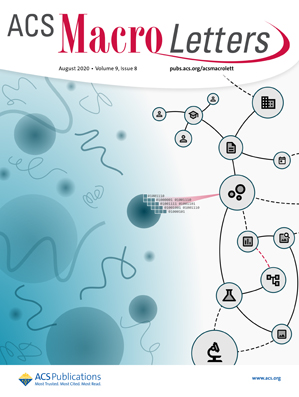Preparation, Characterization, and Self-Assembly of P3HT-Based Janus Fibers via a Crystallization-Driven Self-Assembly Process.
IF 5.2
Q1 POLYMER SCIENCE
引用次数: 0
Abstract
Poly(3-hexylthiophene) (P3HT)-based complex topological copolymers have attracted a great deal of attention for their unique electrical and optical properties. In this contribution, the P3HT-based Janus fibers with controlled lengths were innovatively prepared by sequential crystallization-driven self-assembly (CDSA) of poly(p-tert-butylstyrene)-b-polyisoprene-b-poly(3-hexylthiophene) (PtBS-b-PI-b-P3HT) triblock copolymer, cross-linking of the interlayer PI region, and dissociation of fibers in good solvent. The comprehensive characterizations showed that the PtBS/P3HT Janus fibers have nearly half the width of PtBS-b-PI-b-P3HT fibers and fiber lengths close to or slightly shorter than those of PtBS-b-PI-b-P3HT fibers, indicating that the Janus fibers with adjustable lengths could be prepared in a large window range. Furthermore, the PtBS/P3HT Janus fibers could re-self-assemble into average 2- or 4-aggregates in selective solvent. The work provided a general strategy to produce P3HT-based or analogous π-conjugated polymer-based Janus fibers, which is hoped to facilitate the applications of π-conjugated polymers in advanced materials.基于p3ht的Janus纤维的制备、表征和自组装的结晶驱动自组装工艺。
聚(3-己基噻吩)(P3HT)基复合拓扑共聚物因其独特的电学和光学性能而受到广泛关注。本文采用连续结晶驱动自组装(CDSA)、层间PI区交联以及纤维在良好溶剂中解离的方法制备了长度可控的p3ht基Janus纤维。该纤维由聚(对叔丁基苯乙烯)-b-聚异戊烯-b-聚(3-己基噻吩)(PtBS-b-PI-b-P3HT)三嵌段共聚物组成。综合表征表明,PtBS/P3HT Janus纤维的宽度接近PtBS-b- pi -b-P3HT纤维的一半,纤维长度接近或略短于PtBS-b- pi -b-P3HT纤维,表明可以在大窗口范围内制备长度可调的Janus纤维。此外,PtBS/P3HT Janus纤维可以在选择性溶剂中重新自组装成平均的2-或4-聚集体。本研究为制备p3ht基或类似π共轭聚合物基Janus纤维提供了一个总体策略,有望促进π共轭聚合物在先进材料中的应用。
本文章由计算机程序翻译,如有差异,请以英文原文为准。
求助全文
约1分钟内获得全文
求助全文
来源期刊
CiteScore
10.40
自引率
3.40%
发文量
209
审稿时长
1 months
期刊介绍:
ACS Macro Letters publishes research in all areas of contemporary soft matter science in which macromolecules play a key role, including nanotechnology, self-assembly, supramolecular chemistry, biomaterials, energy generation and storage, and renewable/sustainable materials. Submissions to ACS Macro Letters should justify clearly the rapid disclosure of the key elements of the study. The scope of the journal includes high-impact research of broad interest in all areas of polymer science and engineering, including cross-disciplinary research that interfaces with polymer science.
With the launch of ACS Macro Letters, all Communications that were formerly published in Macromolecules and Biomacromolecules will be published as Letters in ACS Macro Letters.

 求助内容:
求助内容: 应助结果提醒方式:
应助结果提醒方式:


